How to Build a New Country
How do you build a country? Is that even something you build? We don’t know but we may have to, and this essay will explain how to achieve that.
We live in a world where it might be faster and cheaper to start a new country than for the FDA to approve a drug. Yes, it may take us less than twelve years and less than $1 billion [1].
1729 is an open-source project to describe and build a new country. [2]
Balaji, an engineer entrepreneur, calls it “The Network State.” He envisions a country you can start from your computer so nations are built from the internet rather than disrupted by it.
“A network state is a social network with a clear leader, an integrated cryptocurrency, a definite purpose, a sense of national consciousness, and a plan to crowdfund territory.”
I want to explain the fundamental concepts to build the Network State but before we do that, let’s talk about how to start a country, where we’ll be located, and our plan to get recognized by the United Nations.
Building the Network State
Building the network state is how we start building a crypto-civilization. A new world where anyone can decide to start or join a country. It will be similar to creating a company where you can create one, or join one as an employee. This new world will be a place to advance free speech, free market, equality of opportunity, privacy, and prosperity.
This will be a place to combine collectivism and individualism to pursue a higher purpose decided by all. Purposes could be setting up a colony in the Moon, only-flying cars cities, figuring out how to live forever, and any other ambitious goal.
“Ok, I get it but how do you actually start a country?”
7 Ways to Start a Country
There are six known ways to start a country. With the additional one, being the one 1729 is pursuing.

Here, we introduce cloud countries. The idea is simple. Cloud-first, land last. Cloud countries are a synonym to the Network State.
We start with what you cannot buy, community. We recruit a group of people who want to build a new country. This will be similar to ethnic diasporas, which are spread all over the world and connected by communications channels and the motherland.
For instance, the Venezuelan diaspora is everywhere but we’re connected because we’re Venezuelans and we can decide to be connected through organizations like Code for Venezuela (technologists solving the country’s issues) or smaller scale such as Panas en Chicago (an area-based organization connecting each other).
We’re starting with a digital community and then we are coming together to build the country.
The land doesn’t even have to be right next to each other. Just like, “Island countries” are separated by the ocean, the country can be joined by the internet. Southwest Asia is the perfect example, pieces of land separated by the ocean. Look at Indonesia.

The network state, in contrast, could look like this.
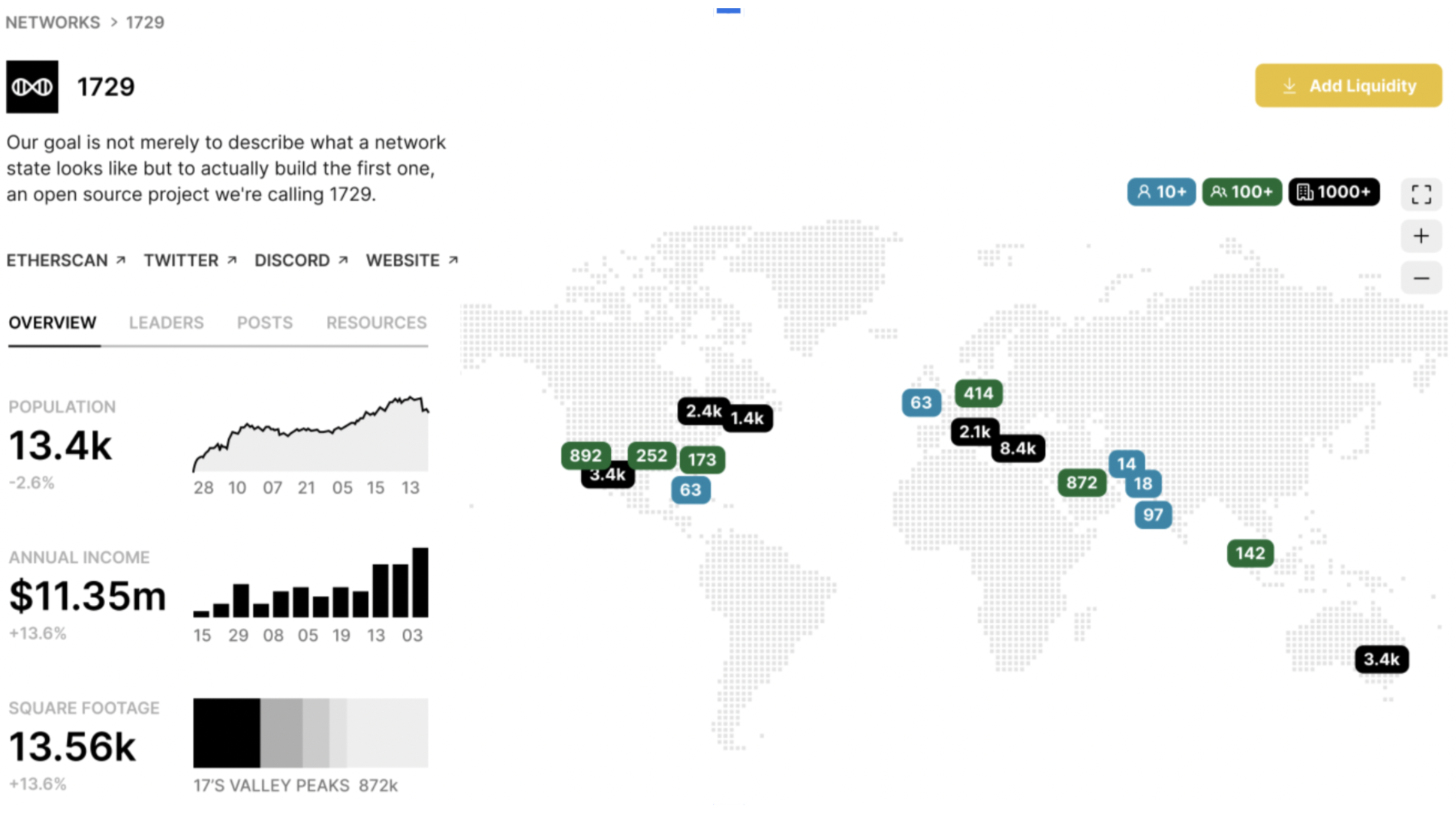
That’s what the Network State will look like. This visual encapsulates many aspects of how the Network State will work.
Next, I want to describe the main pillars behind how we’re building this country.
Core Ideas
Network State
This is how Network States might look like. Here, the Network State 1729 shows metrics such as population, annual income, and square meters.
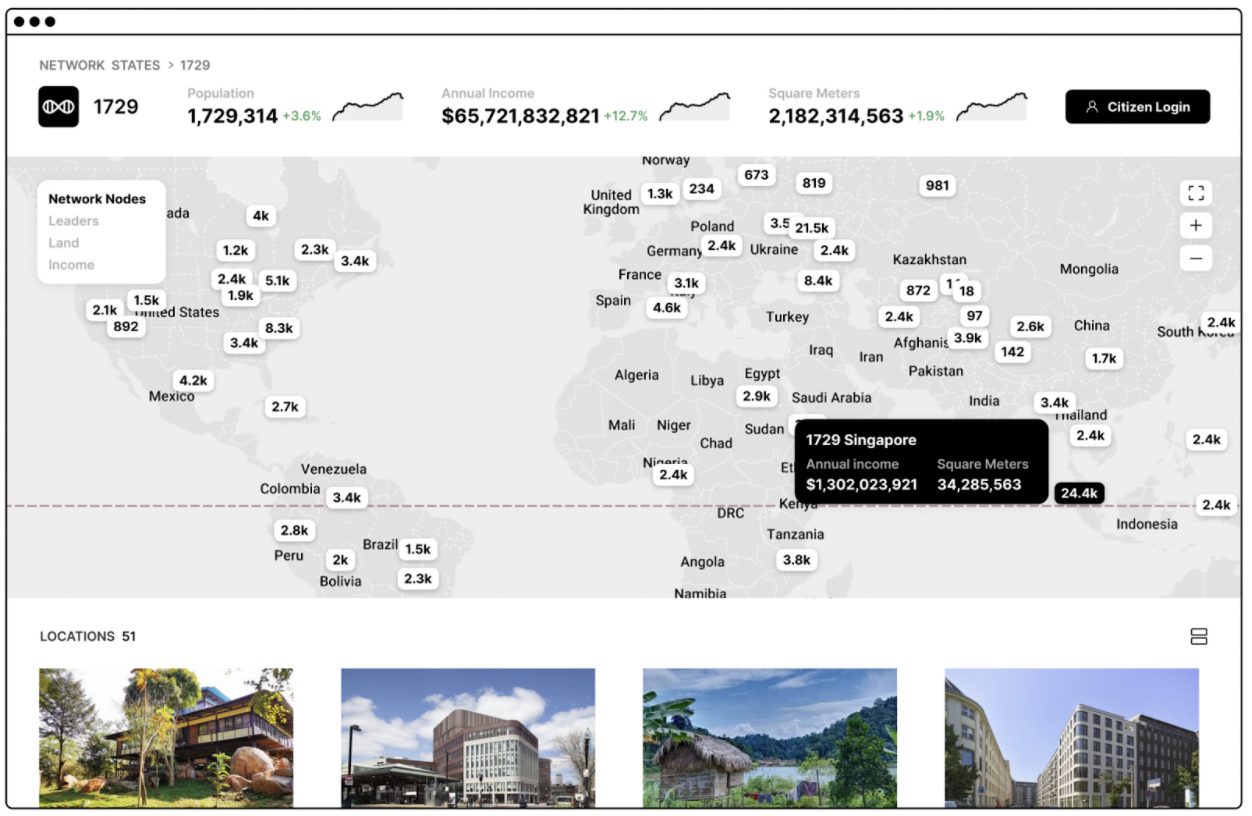
A Centralized East and a Decentralized West
The East has developed a stable autocracy that centralizes power in a seemingly effective/competent way. Although, in some ways, fairly brutal. While the West suffers from large degrees of internal conflict, that makes democracies ineffective. To get anything done in a democracy, there needs to be some degree of internal alignment. This inability to make changes combined with widespread incompetence in many public institutions and technology favoring decentralization will lead to the west decentralizing.
American politicians can make you think we’re on the edge of fascism or communism. In reality, we’re closer to something like American anarchy. Balaji shares some examples:
In the territory governed by this inept bureaucracy, you see power outages, supply chain shortages, rampant flooding, and uncontrolled fires. You see riots, arsons, shootings, stabbings, robberies, and murders. You see digital mobs that become physical mobs. You see a complete loss of trust in institutions from the state to the media. You see anti-capitalism and anti-vaxxism. You see states breaking away from the U.S. federal government, at home and abroad. And you see the End of Power, the Revolt of the Public, the defeat of the military, the inflation of the dollar, and—looming ahead—an American anarchy.
The internet is causing American anarchy and Chinese control. Why settle? When we can build a new country. Let’s build it.
The Ledger of Record
This is the transition from corporations and centralized institutions saying what is true to creating sources of definite truth.

Really? The source of truth? Just like whoever convinces you that you’re a victim is your true oppressor. Whoever convinces you they have the truth is lying the most.
To explain the Ledger of Record, let’s use an example. How do we get and consume most of the information? We look at our feeds. But the thing is, the feed gives us what is popular, not what is true. Bad feeds can kill us. COVID-19 is the most obvious example. Here is a list of examples of confidently delivered, condescending official misinformation on the pandemic.
Another example is how articles are written. Many articles are wrappers around numbers. Sports articles are wrappers around scores. Financial articles are wrappers around tickers. Political articles are wrappers around tweets.
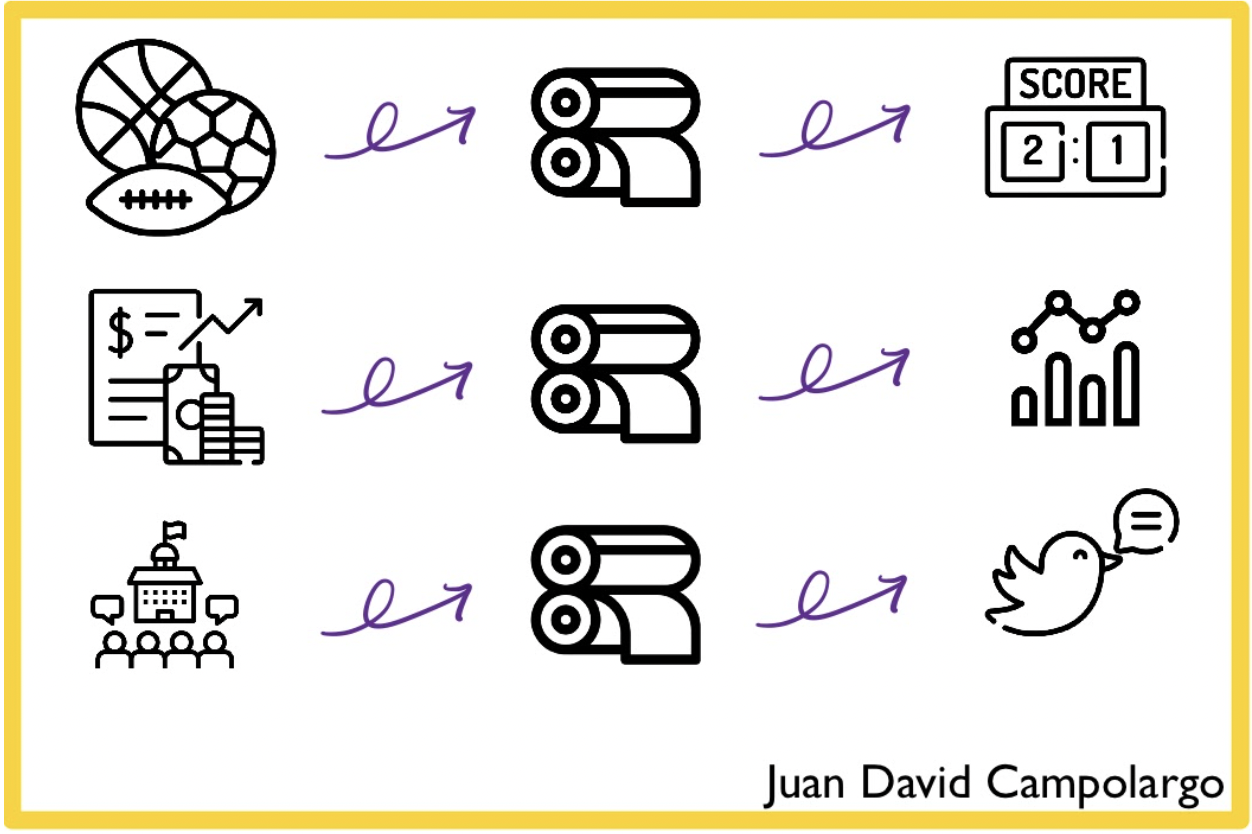
But Satoshi, the guy who invented Bitcoin and the blockchain, figured out how to create a better feed. We want to separate facts from narratives.
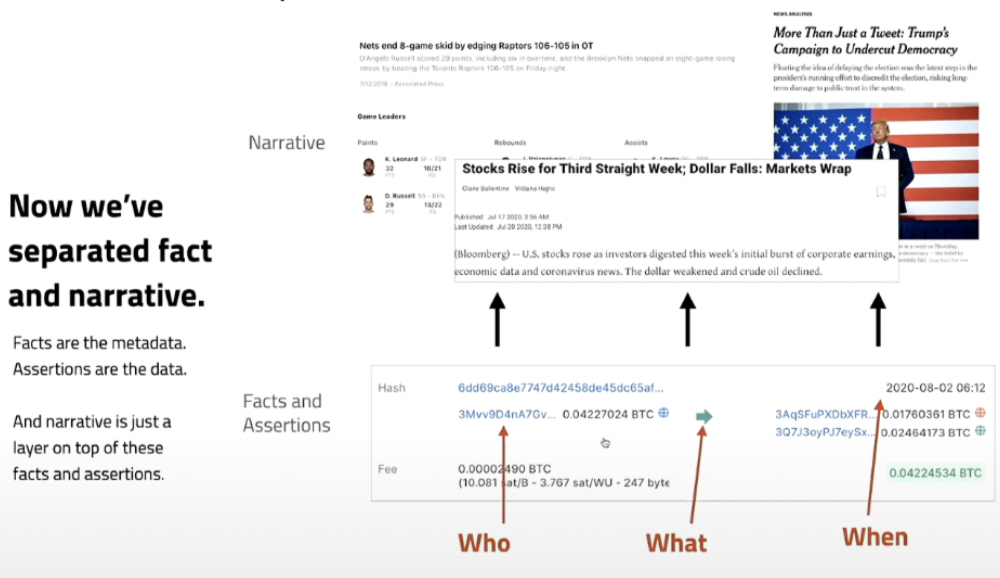
This blockchain technology can separate facts from narratives. Instead of unburying the sources from narrative articles, we can enable a transparent world where the information gets verified immediately through a digital ledger. This also helps with misinformation and censorship.
Today we can prove who did what, when. In the future, we will have proof-of-location, proof-of-space, proof-of-how, and many more.
Regulation is Information
“It is easier to start a new currency than to fix the FED.” Similarly, It is easier to start a new startup city than to fix San Francisco. It is easier to start a new country than to fix regulations.
That does not mean we should end all regulations. The non-solution is to simply “end the FDA.” The solution is to exit the FDA by building an alternative.
Technology is reinventing regulation because regulation is information.
Crowdchoice
The easiest example to understand crowdchoice is when companies make states compete for investment. For instance, when Elon Musk had seven states compete for Tesla’s newest factory. Or when Amazon received 238 proposals from cities to become the site of its second corporate headquarters.
Crowdchoice is how the internet will permit collective bargaining with governments as well as collective migration.
We plan to crowdfund to buy land in the real world using crowdchoice.
Optimalism
Optimism? Pessimism? Optimalism!
Optimalism works by setting an explicit quantitative objective for society to prevent fundamentalism, align people, and track progress.
Currently, we have bad metrics for society. We aren't optimizing the right things. Rather than GPD, GDP per capita, or the stock market. We should have dashboards of longevity, net worth, health, etc.
Optimalism provides a solution. Optimism is an explicit, quantifiable goal for society set via consensus. All public actions, individual and collective, are then measured against it.
Optimalism ties together rational definite optimism, quantitatively optimizing tools, and provable progress.
Cryptouniversity to Cryptoeconomy
We’re starting with a VR lectures series on the Network state. From this course, we’ll create a college. From a college, we’re starting a city. From a city, we’re starting a country.
Cities were built around water, now built around universities. We’re building a cryptouniversity and using it to launch a cryptoeconomy.
We achieve this by combining digital and physical as well as regular physical meetups to build a high trust community.

City in the Cloud
“The key is to go cloud-first, land-last.”
We’re building community first. We’re not worried about real estate, as it can be solved once you have sufficient numbers of people with aligned values.
We plan to negotiate a deal with a state to buy land in the middle of nowhere with specified laws [3]. Then we move.
Below, it’s a graphic of how long cloud companies and movements take shape in the physical world.
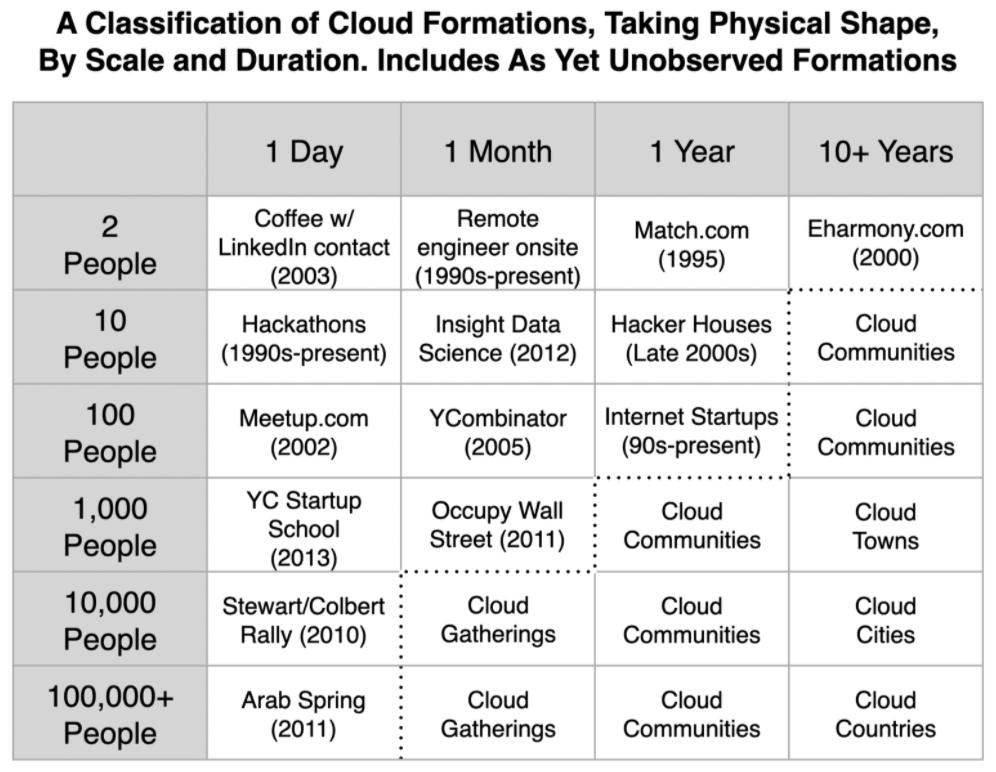
Decentralized Defense
The most important theater of future warfare isn't air, land, or sea, but the cloud.
The only secure backend services in twenty years will be on the blockchain. Why? The chains get stronger with attacks.
Decentralized defense refers to geographical decentralization in terms of owning land in many places in the world. Let’s say Russia goes rogue on us and decides to invade the Network State.
Attempting to do so is like finding every Venezuelan across the world or invading every Bitcoin miner. Digital centralization makes membership invisible in the same way a list of all Facebook members is invisible to all but some Facebook admin.
Hence, a network state is "spread around the globe, with a partially private user list (like Twitter and Facebook) and a physically decentralized footprint (like Bitcoin miners and Google offices), it’d be difficult to nuke it, or invade it, even if you could find it."
Another example is remote work because it’s also a decentralized defense.
The Tech Tree
Let’s say you’re interested in helping to develop ways to live forever. Instead of browsing and guessing what’s important or the best ways to contribute. You would go to the Longevity Tech Tree. In there, you’d find everything you need and what you can do to help. Oh, wait! That already exists.
We’re building a definite future in a decentralized way with a tech tree. It’s like a request-for-startups but with a more interactive and interrelated vision for the future.
The tech tree will be an open-source map of everything. What needs to be built, what needs to be funded, and how it interrelates.
For example, a motivated founder can pick a spot where he’d like to move the field forward.
Inspired by the Foresight Institute, Tech Trees could answer the following questions:
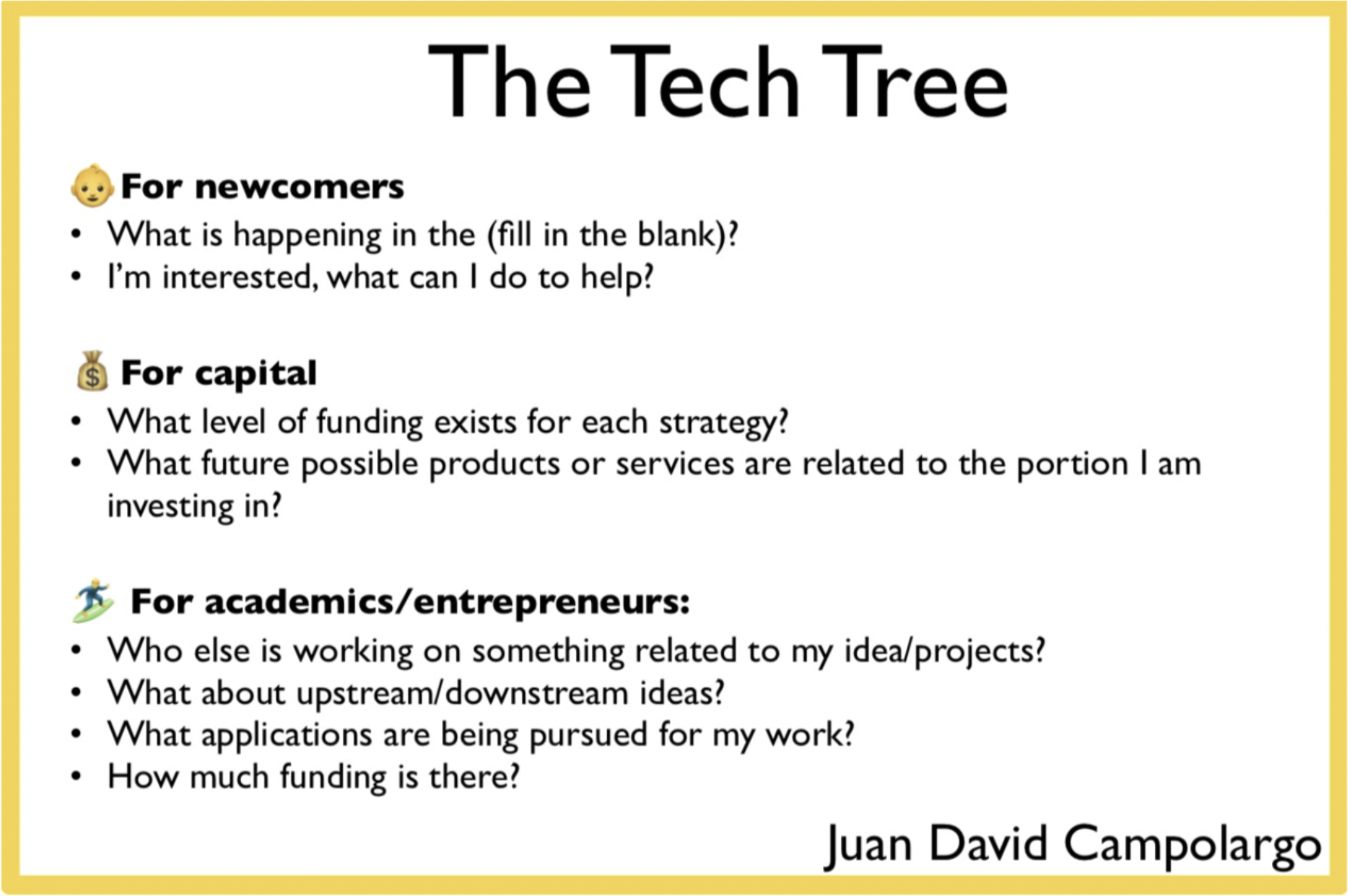
It was time to build. Now, it’s time to exit.
We want to get recognized by the United Nations. Out of the 193 UN-recognized states, approximately 20% of existing countries have a population of less than 1 million, and about 55% have a population of less than 10 million.
If we have 1 - 10 million committed provable cryptocurrency reserves, and physical holdings all over the world, we can probably achieve societal recognition from the United Nations.
I love my original country, Venezuela. I love the country where I live, the United States (3). But I can’t go and reform them from within. Too much bureaucracy, corruption, and misaligned incentives. Even if I wanted to. What am I going to do? Run for office? That sounds like the least effective and slowest way. Even if I become Venezuela’s president today, fixing my beloved country would take decades and decades.
Creating a new country might be a good way. This might be the best way to force bureaucracies to fix themselves. Unless we create a better system, they won’t improve.
The current gerontocrazy. I mean, gerontocracy does not seem to understand that progress, not laws, is the way forward.
With new countries, each country can have its own higher collective purpose decided by all of its citizens.
With 1729, our goal is transcendence, where we win and help win. Our core values are truth, health, and wealth, where all must become excellent to achieve the infinite frontier, immutable money, and eternal life.
1729 isn’t the only one. There are more communities building cities and countries.
Building a new country is the difference between working hard to make progress and achieving it and working hard to make progress and getting stopped by politics.
We aren’t the first ones wanting (or needing) to build a new country. This movement reminds me of Israel’s history. Both old and modern-day Israel. Just as the Jews were given the Promised Land and how Theodor Herzl envisioned the new Jewish state in a book. Creating a new country, where we start with a clean slate and a fresh start, is how we build the future we want.
It’s time.
Notes
[1] “The average time from FDA application to approval of drugs is 12 years, and the estimated average cost of taking a new drug from concept to market exceeds $1 billion.”
[2] Why 1729? Where does the number come from? Is it a year?
Balaji explained:
It’s not a year, it’s the first number that’s the sum of two cubes in two different ways.
And what that refers to, it’s basically the Ramanujan number. So Srinivasa Ramanujan was India’s greatest mathematician and kind of like India’s Einstein, but has kind of a romantic story in the sense that he was extremely poor and wrote these letters to mathematicians around the world.
He had just self-taught math from a textbook. He wrote these letters to mathematicians around the world, and most of them ignored him, just thought he was a crank. And one guy brought him out to England, this guy G.H. Hardy, who thought this guy has to be a genius because no one would make up these equations.
And so then Ramanujan began a rampage through mathematics and has people still to this day going through a page of his notebooks for an entire mathematical journal issue, because he just wrote down all these results that were true, but he didn’t provide the proof. You just intuit the result. So where does 1729 come from, 1729?
[3] Why is the land in the middle of nowhere viewed as desirable? You could argue that if it was desirable to live on, presumably there would already be others there.
Land in the middle of nowhere isn’t necessarily desirable and you need to build infrastructure and so on. The reason is that it’s more affordable and there are few or no people there. The details will get clearer as we approach that stage.
[4] Is the United States worth fighting for? Of course! It’s easy to think creating a new country is giving up on the U.S. Creating a new country is the most patriotic act we can do for this country. I love the U.S. I want the continue to be the best country in the world. But we must redesign our institutions and remember our values to move forward and get back to the future. God bless America! But let’s help God a little bit.
Thanks to Matt, Antoine, Josca, and Abhisek for reading drafts of this essay.
Learn about 1729 and the Network State:
If you’re into interesting ideas (like the one you just read), join my Weekly Memos., and I’ll send you new essays right when they come out.